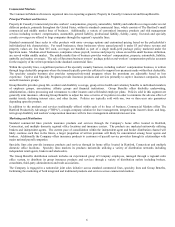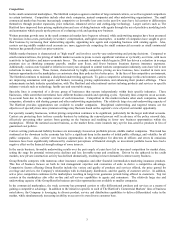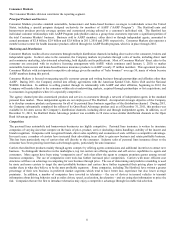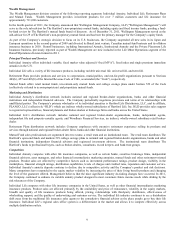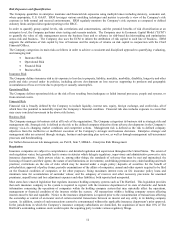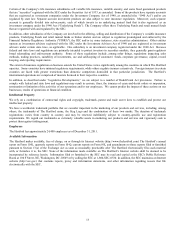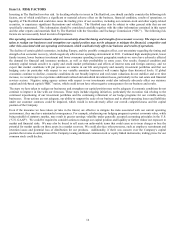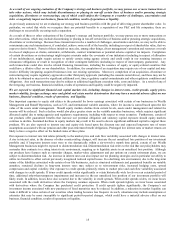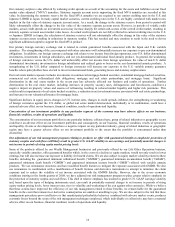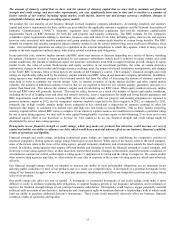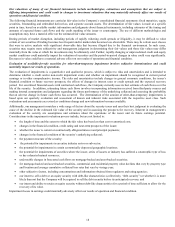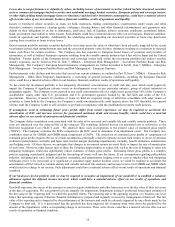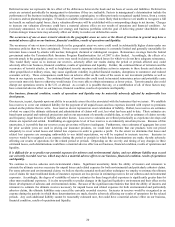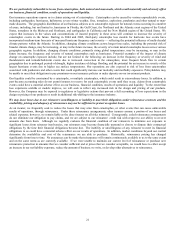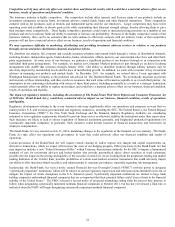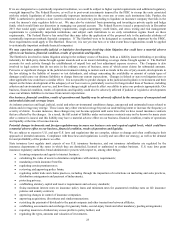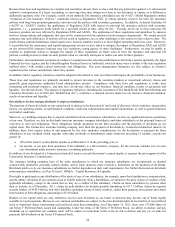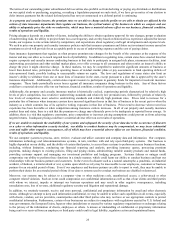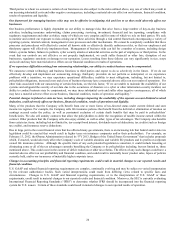The Hartford 2011 Annual Report Download - page 16
Download and view the complete annual report
Please find page 16 of the 2011 The Hartford annual report below. You can navigate through the pages in the report by either clicking on the pages listed below, or by using the keyword search tool below to find specific information within the annual report.16
Our statutory surplus is also affected by widening credit spreads as a result of the accounting for the assets and liabilities on our fixed
market value adjusted (“MVA”) annuities. Statutory separate account assets supporting the fixed MVA annuities are recorded at fair
value. In determining the statutory reserve for the fixed MVA annuities we are required to use current crediting rates in the U.S. and
Japanese LIBOR in Japan. In many capital market scenarios, current crediting rates in the U.S. are highly correlated with market rates
implicit in the fair value of statutory separate account assets. As a result, the change in the statutory reserve from period to period will
likely substantially offset the change in the fair value of the statutory separate account assets. However, in periods of volatile credit
markets, actual credit spreads on investment assets may increase sharply for certain sub-sectors of the overall credit market, resulting in
statutory separate account asset market value losses. As actual credit spreads are not fully reflected in current crediting rates in the U.S.
or Japanese LIBOR in Japan, the calculation of statutory reserves will not substantially offset the change in fair value of the statutory
separate account assets resulting in reductions in statutory surplus. This has resulted and may continue to result in the need to devote
significant additional capital to support the fixed MVA product.
Our primary foreign currency exchange risk is related to certain guaranteed benefits associated with the Japan and U.K. variable
annuities. The strengthening of the yen compared with other currencies will substantially increase our exposure to pay yen-denominated
obligations. In addition, our foreign currency exchange risk relates to net income from foreign operations, non-U.S. dollar denominated
investments, investments in foreign subsidiaries, and our yen-denominated individual fixed annuity product. In general, the weakening
of foreign currencies versus the U.S. dollar will unfavorably affect net income from foreign operations, the value of non-U.S. dollar
denominated investments, investments in foreign subsidiaries and realized gains or losses on the yen denominated annuity products. A
strengthening of the U.S. dollar compared to foreign currencies will increase our exposure to the U.S. variable annuity guarantee
benefits where policyholders have elected to invest in international funds, generating losses and statutory surplus strain.
Our real estate market exposure includes investments in commercial mortgage-backed securities, residential mortgage-backed securities,
commercial real estate collateralized debt obligations, mortgage and real estate partnerships, and mortgage loans. Significant
deterioration in the real estate market in the recent past has adversely affected our business and results of operations. Further
deterioration in the real estate market, including increases in property vacancy rates, delinquencies and foreclosures, could have a
negative impact on property values and sources of refinancing resulting in reduced market liquidity and higher risk premiums. This
could result in impairments of real estate backed securities, a reduction in net investment income associated with real estate partnerships,
and increases in our valuation allowance for mortgage loans.
Significant declines in equity prices, changes in U.S. interest rates, changes in credit spreads, inflation, the strengthening or weakening
of foreign currencies against the U.S. dollar, or global real estate market deterioration, individually or in combination, could have a
material adverse effect on our business, financial condition, results of operations and liquidity.
Concentration of our investment portfolio in any particular segment of the economy may have adverse effects on our business,
financial condition, results of operations and liquidity.
The concentration of our investment portfolios in any particular industry, collateral type, group of related industries or geographic sector
could have an adverse effect on our investment portfolios and consequently on our business, financial condition, results of operations
and liquidity. Events or developments that have a negative impact on any particular industry, group of related industries or geographic
region may have a greater adverse effect on our investment portfolio to the extent that the portfolio is concentrated rather than
diversified.
Our adjustment of our risk management program relating to products we offer with guaranteed benefits to emphasize protection of
statutory surplus and cash flows will likely result in greater U.S. GAAP volatility in our earnings and potentially material charges to
net income in periods of rising equity market pricing levels.
Some of the products offered by our Wealth Management businesses and previously offered by our Life Other Operations business,
especially variable annuities, offer guaranteed benefits which, in the event of a decline in equity markets, would not only result in lower
earnings, but will also increase our exposure to liability for benefit claims. We are also subject to equity market volatility related to these
benefits, including the guaranteed minimum withdrawal benefit (“GMWB”), guaranteed minimum accumulation benefit (“GMAB”),
guaranteed minimum death benefit (“GMDB”) and guaranteed minimum income benefit (“GMIB”) offered with variable annuity
products. We use reinsurance structures and have modified benefit features to mitigate the exposure associated with GMDB. We also
use reinsurance in combination with a modification of benefit features and derivative instruments to attempt to minimize the claim
exposure and to reduce the volatility of net income associated with the GMWB liability. However, due to the severe economic
conditions starting in the fourth quarter of 2008, we have adjusted our risk management program to place greater relative emphasis on
the protection of statutory surplus and cash flows. This shift in relative emphasis has resulted in greater U.S. GAAP earnings volatility
and, based upon the types of hedging instruments used, can result in potentially material charges to net income in periods of rising
equity market pricing levels, lower interest rates, rises in volatility and weakening of the yen against other currencies. While we believe
that these actions have improved the efficiency of our risk management related to these benefits, we remain liable for the guaranteed
benefits in the event that reinsurers or derivative counterparties are unable or unwilling to pay. We are also subject to the risk that these
management procedures prove ineffective or that unanticipated policyholder behavior, combined with adverse market events, produces
economic losses beyond the scope of the risk management techniques employed, which individually or collectively may have a material
adverse effect on our business, financial condition, results of operations and liquidity.


